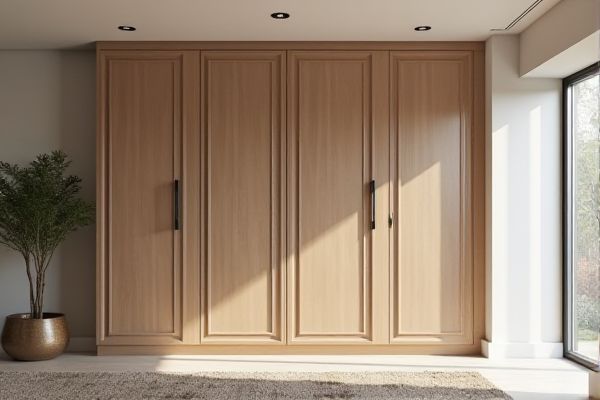
Folding door cabinets offer space-saving benefits by opening outward in panels, making them ideal for tight areas, whereas sliding door cabinets glide along tracks and provide easy access without requiring clearance in front. Discover the advantages and drawbacks of each option to decide which cabinet style best suits Your storage needs by reading the rest of the article.
Table of Comparison
| Feature | Folding Door Cabinet | Sliding Door Cabinet |
|---|---|---|
| Space Efficiency | Requires clearance to open doors outward | Doors slide sideways, ideal for tight spaces |
| Installation Complexity | Simple hinges, easier installation | Requires track system, more complex |
| Accessibility | Full access when doors fully open | Partial access as only one side opens at a time |
| Maintenance | Fewer moving parts, easier maintenance | Tracks need regular cleaning and adjustments |
| Durability | Durable hinges, less prone to track issues | Track wear can affect door function over time |
| Design & Style | Traditional look, classic design | Modern appearance, sleek design |
Introduction to Folding Door Cabinets and Sliding Door Cabinets
Folding door cabinets feature panels that fold back against themselves, allowing easy access to contents without requiring much clearance space. Sliding door cabinets use doors that move horizontally along tracks, ideal for tight spaces where outward door swing is impractical. Your choice between these cabinet types depends on room layout, usage frequency, and space optimization needs.
Design Features of Folding Door Cabinets
Folding door cabinets feature hinged panels that fold together, allowing full access to the cabinet interior without requiring extra space for door swing. Their design includes multiple segments connected by pivots, offering a compact and versatile solution ideal for tight spaces. You benefit from increased accessibility and modern aesthetics, making folding door cabinets a practical choice for contemporary interiors.
Design Features of Sliding Door Cabinets
Sliding door cabinets feature space-saving design with doors that glide horizontally along tracks, eliminating the need for clearance in front of the cabinet. Their sleek mechanism offers smooth operation and modern aesthetics, often enhanced by materials like tempered glass, aluminum, or wood veneers. This design is ideal for tight spaces and provides easy access to contents without obstructing adjacent areas.
Space Efficiency Comparison
Folding door cabinets maximize space by allowing doors to fold inward, making them ideal for narrow or tight areas where full door swing clearance is limited. Sliding door cabinets save space by moving doors horizontally along a track, eliminating the need for door clearance and enabling placement in confined or high-traffic zones. Both designs enhance storage accessibility while optimizing room layout based on specific spatial constraints.
Accessibility and Ease of Use
Folding door cabinets offer improved accessibility by allowing the entire cabinet interior to be visible when the doors are open, making it easier for you to reach items without obstruction. Sliding door cabinets save space by sliding doors sideways, but often limit access to only one side of the cabinet at a time, which can be less convenient for quick retrieval. For ease of use, folding doors require more clearance space to open fully, whereas sliding doors function smoothly in tight spaces without interfering with surrounding areas.
Aesthetic Appeal and Style Options
Folding door cabinets offer a versatile aesthetic with their accordion-style design, creating a dynamic visual effect that suits contemporary and eclectic interiors. Sliding door cabinets provide a sleek, minimalist look ideal for modern and space-saving environments, with clean lines and a seamless appearance. Your choice depends on whether you prefer the bold, statement-making style of folding doors or the understated elegance and practicality of sliding doors.
Durability and Maintenance Considerations
Folding door cabinets typically feature hinges and multiple panels, which may require more frequent maintenance to prevent wear and misalignment over time compared to sliding door cabinets that operate on track systems offering smoother movement and fewer mechanical parts. Sliding door cabinets tend to be more durable in high-traffic areas due to their compact operation and reduced risk of hinge damage, while folding doors can suffer from hinge loosening and panel warping if not properly maintained. Choosing sliding door cabinets can minimize the need for regular upkeep, making them a practical option for long-term durability and easier maintenance.
Cost Analysis: Folding vs Sliding Door Cabinets
Folding door cabinets typically have lower initial costs due to simpler hardware and construction, while sliding door cabinets often involve higher expenses because of complex tracks and rollers. Maintenance costs for folding doors can be higher in high-traffic areas due to hinge wear, whereas sliding doors may require less upkeep but more costly repairs if track issues arise. Your choice should consider both upfront investment and long-term maintenance expenses to optimize budget efficiency.
Best Applications for Each Cabinet Type
Folding door cabinets are best suited for compact spaces where door swing clearance is limited, making them ideal for closets and small rooms. Sliding door cabinets excel in areas with high foot traffic or narrow corridors, providing easy access without obstructing walkways, perfect for offices or living rooms. Your choice depends on space constraints and the ease of access required for your specific environment.
Choosing the Right Cabinet for Your Space
Folding door cabinets maximize accessibility in compact spaces by allowing full door opening without requiring extra clearance, making them ideal for narrow rooms or tight corners. Sliding door cabinets save space by gliding doors along tracks, which is perfect for areas where floor space is limited but wall space is ample. Careful consideration of room layout, door swing clearance, and ease of access ensures selecting a cabinet that enhances both functionality and spatial efficiency.
 homyna.com
homyna.com